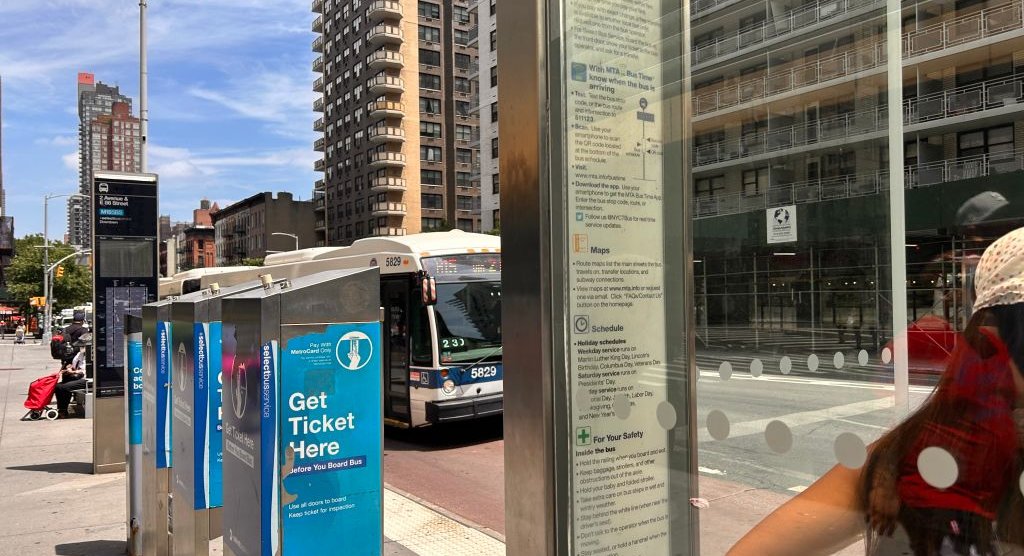Some bus stops in New York City can be nearly 15 degrees hotter than their cooler counterparts during the summer, and the hottest stops tend to be in low-income communities with predominantly people of color — particularly in Queens and the Bronx — a new report by NASA and transit advocacy group Transportation Alternatives finds.
The report, released on Monday, used thermal imaging satellites to analyze temperatures at bus stops across the city and identified 100 stops and three routes that the authors said needed urgent intervention. All of those stops lacked bus shelters and 64% had no trees within 25 feet to give riders cover. There were also fewer alternate transit options within a five-minute walk of the stops, and the average bus speed was slower than the MTA average by almost 1 mph, according to the report.
Most of the priority bus stops were located in several City Council districts where residents were disproportionately Black, Latino and low-income, the report found. The districts’ asthma rates were 88% higher than the citywide average, putting residents at higher risk of heat-related illness and the effects of climate change.
Meanwhile, the coolest bus stops identified in the report were more likely to have bus shelters on streets with trees, green spaces and bodies of water. And nearly twice as many white residents lived near the coolest stops than the hottest, even though the overall number of residents who lived near the hottest and coolest stops was about the same.
Elizabeth Adams, Transportation Alternatives’ interim co-executive director, said the city’s current infrastructure forces millions of people to wait in sweltering heat for buses.
“The data shows, time and time again, that wealthier and whiter communities are waiting at cooler, safer bus stops,” she said in a statement. “This is a policy choice that is entirely solvable, and we hope to see our city’s leaders make real, tangible changes to protect New Yorkers from excessive heat.”
According to Transportation Alternatives and its partners at NASA’s DEVELOP Environmental Justice team, the seven hottest bus stops were located in the Bronx and averaged 11 degrees hotter than the citywide average. The borough had 27% of the city’s hottest bus stops despite having only 12% of all its bus stops. And in Queens, which had more than half of the 400 balmiest bus stops, almost two-thirds of bus stops ran hotter than the citywide average.
The researchers’ interactive map of city bus stop temperatures is available on Transportation Alternatives’ website. It measures what’s known as the urban heat island effect, whereby the built environment — concrete, blacktops, densely packed tall buildings and traffic — increases the “real-feel” temperature.
A spokesperson for the MTA referred to the city Department of Transportation as the agency responsible for overseeing the city’s bus stops and streetscape. The MTA is charged with running the buses, not building and maintaining bus shelters.
DOT officials said many of the locations identified in the report could not accommodate bus shelters because they did not meet specific criteria, including adequate sidewalk space for accessibility and safety reasons. For example, new shelters must leave a minimum clear path that’s 7 feet wide and all shelters must be at least three feet from the curb.
“When siting bus shelters, we focus on historically underserved areas, ridership data, and proximity to bus priority routes,” a DOT spokesperson said in a statement on Monday, adding that the agency looks “forward to adding hundreds of additional bus shelters in the coming years.”
The agency also said it considers other criteria when deciding where to place bus shelters, such as ridership, priority bus lanes, equity concerns and City Council requests. There are more than 3,500 bus shelters in the city out of 15,000 total stops, and 300 more shelters are planned over the next two years, according to the DOT, which cited a higher concentration of existing shelters in areas deemed historically underserved.
On average, 350 New Yorkers die annually from preventable heat illness, city officials said. The city’s health commissioner recently described climate change and extreme heat as a public health crisis, and the city has experienced a record number of heat emergencies this summer.
